|
Our Taxes Are Off to War - 2012 Edition |
[The following article first appeared on DailyKos.]
In the current fiscal year (FY2012), the government estimates that $716.3 billion will be spent on the military. Adjusted for inflation, this is 69% more than the amount spent in FY2000. As the chart below shows, President Obama plans to reduce military spending in coming years, mostly by reducing forces in Afghanistan, resulting in a 25% drop by FY2017 (inflation adjusted), but spending will still be 28% higher than in FY2000 (at the beginning of the Bush administration).
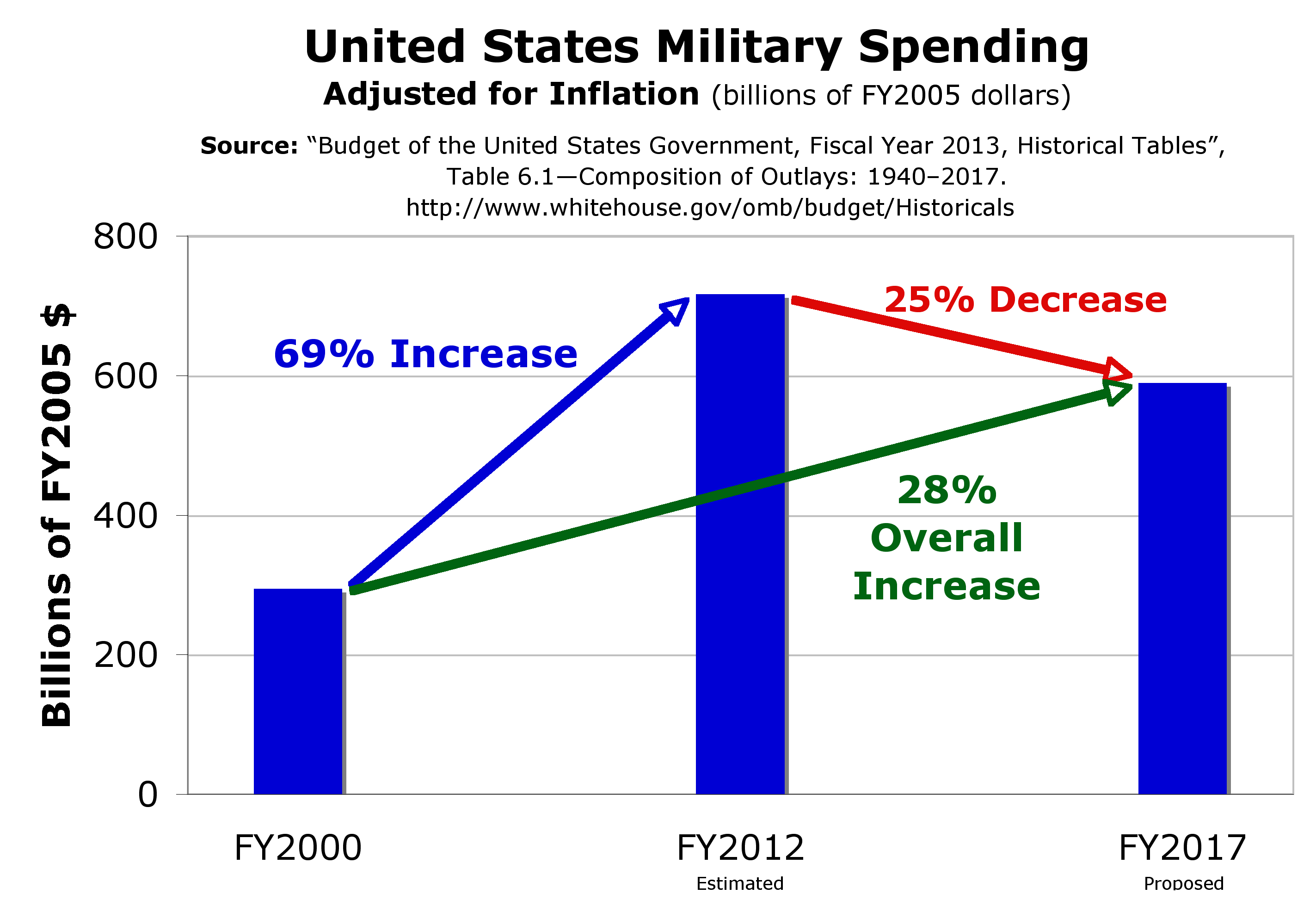
This chart shows “national security” (050) spending which consists of the full Department of Defense budget, spending for nuclear weapons in the Department of Energy, and “Defense-related activities” in other departments.
The charts below show how our income tax dollars were spent in the year just completed — FY2011 — which ended last September 30 (data from Budget of the United States Government: Historical Tables Fiscal Year 2013, Table 8.7). As you can see, the government sent $699 billion or 51.9% of all discretionary funds (those allocated by Congress in appropriation bills) to the military ("National Defense"). This represents an average of about $5,894 from each of the 118.7 million households in the US.
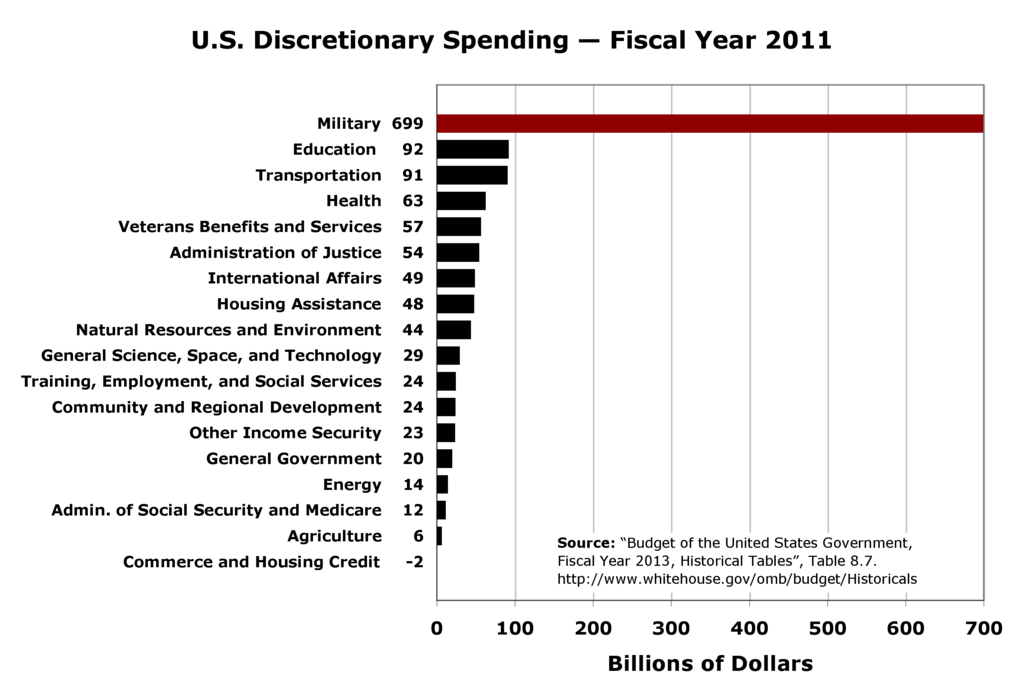
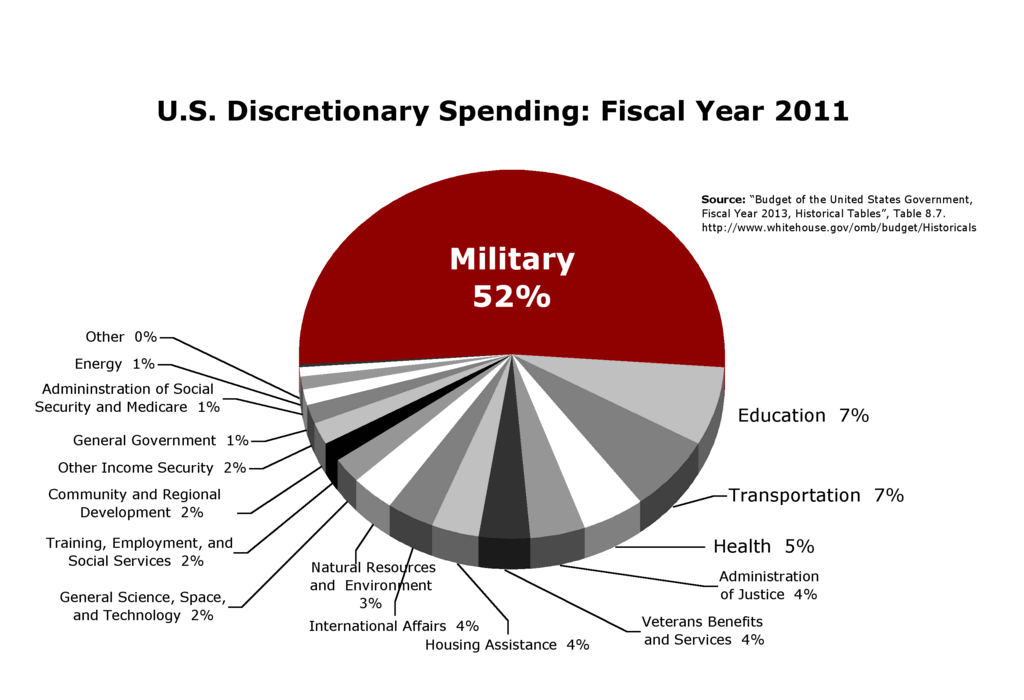
These two charts show the “discretionary” part of the federal budget — that is, the part that Congress and the President directly allocate each year (with the funds derived from our income taxes, corporation taxes, excise taxes, estate and gift taxes, and other miscellaneous taxes). These figures exclude expenditures for Social Security, Medicare, and federal highways since these programs are paid from dedicated taxes maintained in separate trust funds. They also exclude interest paid on the national debt since that spending is “mandatory,” not “discretionary.” Funding for Federal Employee Retirement Benefits, Unemployment Benefits, and means-tested entitlements like Veterans Benefits, Medicaid, SSI, and food stamps are also mandated by on-going legislation and so are not included in the discretionary budget.
Winslow T. Wheeler adds up all the spending in every part of the budget related to national security ("Which Pentagon Budget Numbers Are Real? You Decide!") and finds it totals $986.1 billion in FY2012.
U.S. Military Spending in the Past 70 Years
Military spending in inflation-adjusted dollars is now greater than at any time since World War II -- even greater than during the peak spending years of the Vietnam War, the Korean War, and the Persian Gulf War (see the chart below — data from Table 6.1).
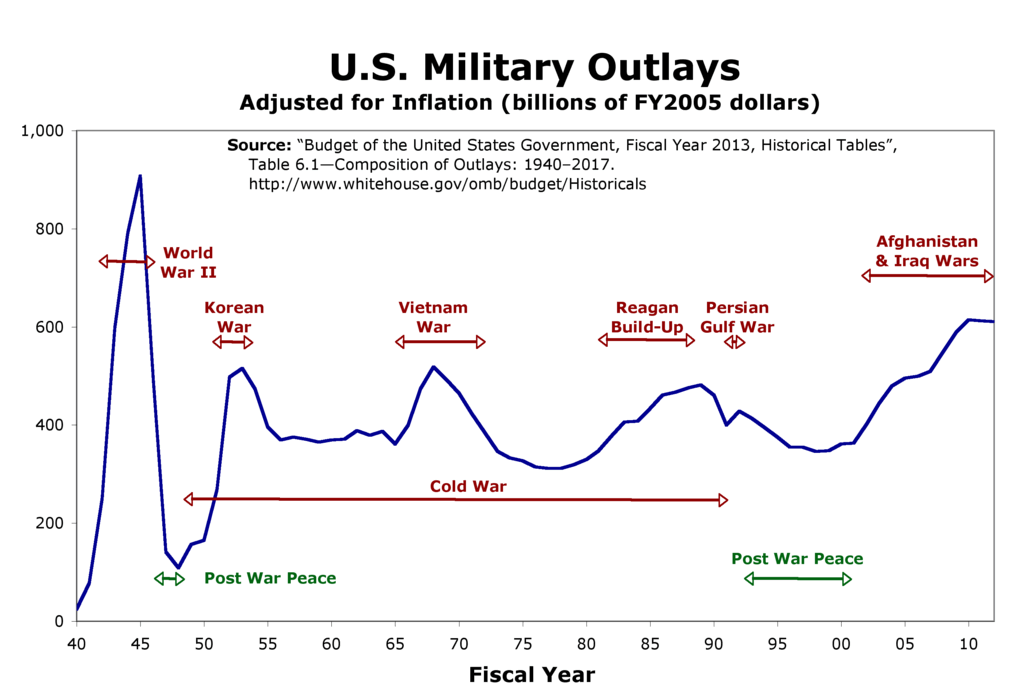
Military spending has been a major contributor to the annual federal deficit. Compare the chart below (data from Table 1.3) with the one above.

Arms Sales
The United States is now the largest supplier of weapons to the world. According to a Congressional Research Service report (pdf), in 2008, the U.S. sold $37.8 billion in arms to other countries — nearly 70% of all weapons sales around the world. These weapons, often subsidized by the U.S. government and sold to undemocratic countries and human rights abusers, may lead to future wars. Some of these weapons may end up being used against the U.S. military or against civilians, as they have in the past (for example: Iraq 2004/5, Afghanistan 2009, Israel 2009).
Is Massive Spending on the Military Needed?
Since the demise of the Soviet Union twenty years ago, the United States has no significant military adversaries. The only countries or groups that express hostility towards the United have small military capabilities.
This contrasts with the period just before World War II when Germany and Japan had massive military forces and the United States had relatively few resources, many of which were destroyed in the attack on Pearl Harbor.
Now, the United States has the most powerful military that has ever existed in the history of the world. We have more than enough firepower to obliterate any enemy. The nuclear weapons in the U.S. arsenal are powerful enough to destroy much of the planet and make our world completely uninhabitable. Moreover, U.S. conventional military force is mighty enough that we can wage two large wars simultaneously far from our shores. The U.S. has over 1,000 military bases around the world and 11 aircraft carriers circling the planet (and no potential adversary has more than 1). The U.S. spends more on the military than the next 15 countries combined and vastly more than any possible enemies: roughly 6 times more than China, 12 times more than Russia, and 98 times more than Iran. The United States and its strongest allies (the NATO countries, Japan, South Korea, and Australia) together spend about $1.1 trillion on their militaries, representing 72 percent of the world’s total.
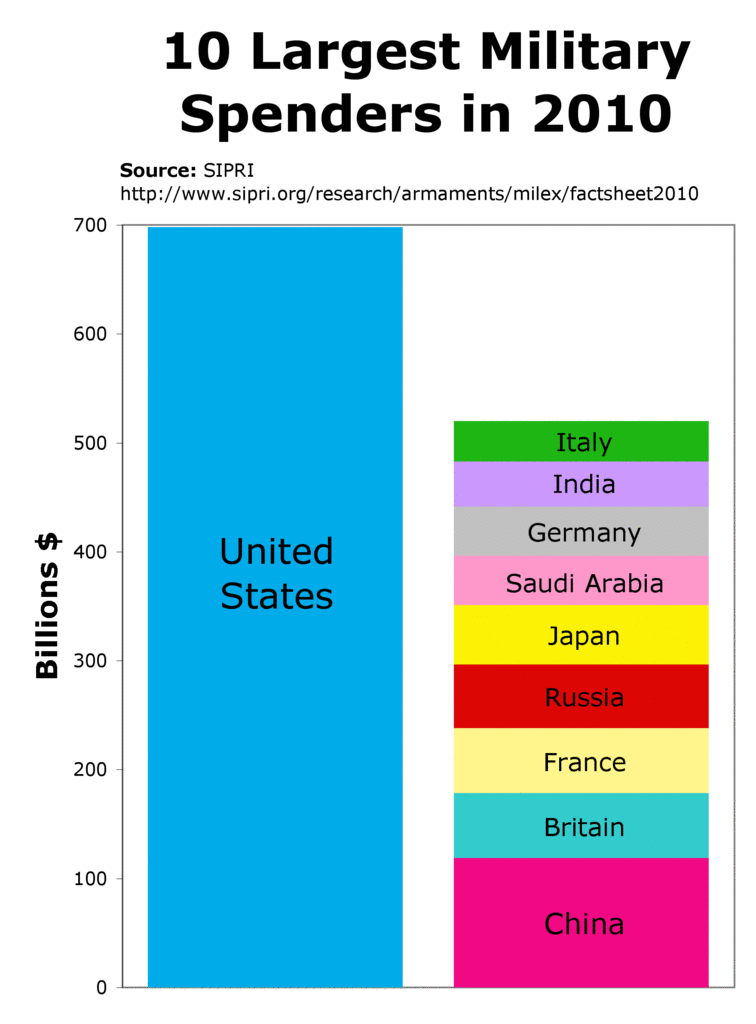
Despite this massive amount of spending on the military, 47% of Americans are still fearful that our military is somehow inadequate. This may be because most mainstream commentary on the military is provided by pro-military retired generals, many of them on the payroll of military contractors.
President Eisenhower warned us in his farewell speech in 1961 to be wary of the military-industrial complex:
In the councils of government, we must guard against the acquisition of unwarranted influence, whether sought or unsought, by the military-industrial complex. The potential for the disastrous rise of misplaced power exists and will persist. We must never let the weight of this combination endanger our liberties or democratic processes.
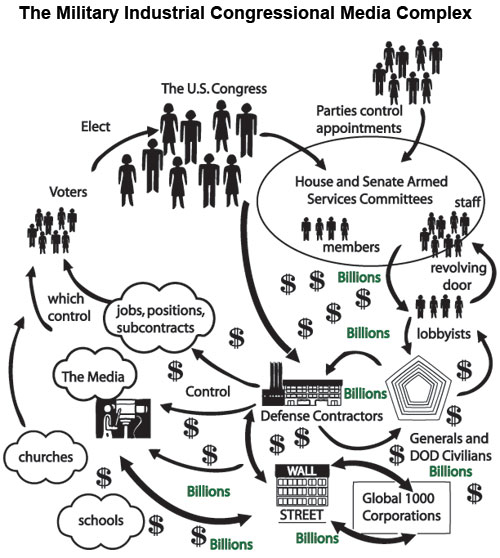
[graphic: Todd Boyle, Rosehill Anti War]
Rather than building a defense structure that protects us, Congress (especially the House and Senate Committees on Armed Services), the Department of Defense, and military contractors have forged an Iron Triangle that provides money and power for all of them — but at our expense. Military contractors spend enormous amounts giving large campaign contributions to Congress and lobbying. In turn, Congress provides them with lucrative, often no-bid, contracts and weak oversight. Military contractors also lobby top DoD administrators and offer them high-paying jobs after they leave the government (revolving door syndrome) and in turn DoD administrators lobby Congress for more weapons and encourage them to overlook contractor cost overruns. Now many services formerly carried out by enlisted personnel are provided by private contractors including expensive and poorly-controlled mercenaries.
Massive military spending, especially if it is corrupt and wasteful, does not provide security. The 9/11 terrorist attacks demonstrated that 19 guys (mostly from Saudi Arabia, an ally) armed with box cutters can attack the United States more effectively than massive armies. Huge expenditures on military personnel and weapons are ineffective in protecting us. It is also clear — as all the U.S. intelligence agencies have warned us — that the Iraq war and the “War on Terrorism” have actually made us less safe.
Real Security
Real security does not come by threatening or bullying, but by respecting and working together with others.
1. The best security is provided by not having enemies, and the best way to achieve this is to treat other countries and their people well. Invading and occupying other countries, supporting dictators, and torturing people who disagree with us are great ways to make lots of long-lasting enemies. As New York Times reporter Stephen Kinzer documented in his book Overthrow: America’s Century of Regime Change from Hawaii to Iraq, in the past 110 years, the United States has used military force in dozens of places around the world to gain access to oil and other natural resources, secure cheap labor, stifle dissent, and crush the efforts of opposition political movements. For example, the United States has obstructed independence movements in Cuba, Puerto Rico, the Philippines, and Nicaragua. It has staged covert actions to overthrow democratically-elected governments in Iran in 1953, Guatemala in 1954, and Chile in 1973. And it has invaded the Dominican Republic (most recently in 1965), Grenada in 1983, Panama in 1989, Afghanistan in 2001, and Iraq in 2003. Moreover, the U.S. has supported and helped to arm dozens of dictators including the Shah of Iran (Shah Mohammed Reza Pahlevi), P.W. Botha in apartheid South Africa, Augusto Pinochet in Chile, General Suharto in Indonesia, Francois “Doc” Duvalier and Jean Claude Duvalier (Baby Doc) in Haiti, George Papadopoulos in Greece, Anastasio Somoza, Jr. in Nicaragua, King Fahd bin Abdul of Saudi Arabia, General Pervez Musharraf in Pakistan, and Hosni Mubarek in Egypt.
3. The third best way to provide security is to build strong domestic support. Spending much of our tax money on the military instead of on important domestic needs is a great way to impoverish our country and undercut domestic support for our government and society.
4. The best way to provide security against terrorist organizations is to address their political grievances or to use police and intelligence agencies to stop their leaders. A recent Rand Corporation research study (“How Terrorist Groups End: Lessons for Countering al Qa’ida”) found:
All terrorist groups eventually end. But how do they end? The evidence since 1968 indicates that most groups have ended because (1) they joined the political process (43 percent) or (2) local police and intelligence agencies arrested or killed key members (40 percent). Military force has rarely been the primary reason for the end of terrorist groups...
But What About Toppling Repressive Regimes?
Don’t we need a strong military to save people from oppressive and genocidal regimes? Actually, as the recent revolutions in Tunisia and Egypt have vividly shown, the most effective and most ethical means to overthrow vicious dictators and undermine horribly repressive regimes is nonviolent action carried out by civic groups within those countries. In addition to the recent revolutions, in the last three decades, nonviolent people-power has toppled the apartheid regime in South Africa, deposed the dictatorships of Slobodan Milosevich in Yugoslavia, Ferdinand Marcos in the Philippines, and Augusto Pinochet in Chile, and brought down the former Soviet Union and its communist satellite states (including Poland, East Germany, Czechoslovakia, and Lithuania). Overthrowing those regimes incurred relatively few casualties and wrought relatively little destruction. The nonviolent overthrow of these regimes has mostly left these countries stronger, more civilized, and much more free and democratic.
A 2005 study (2.3 MB pdf) by Freedom House found that in the 67 cases since 1972 in which dictatorial systems fell or new states arose from the disintegration of multinational states, “civic resistance was a key factor in driving 50 of 67 transitions” — over 70%. In 32 of the 67 countries (nearly 48%),
strong, broad-based nonviolent popular fronts or civic coalitions were highly active, and in many cases central to steering the process of change... Now, years after the transition, 24 of the countries (75 percent) where a strong nonviolent civic movement was present are Free and democratic states and 8 (25 percent) are Partly Free states with some space for civic and political life.
In contrast, only one transition to freedom (Panama, 1989) was brought about by an outside military force. They also found that
the stronger and more cohesive the nonviolent civic coalition operating in societies in the years immediately preceding the transition, the deeper the transformation in the direction of freedom and democracy.
Conclusion
Spending on military force, in inflation-adjusted dollars, has grown to a level 25 times as high as it was in 1940 (Table 6.1). Over the years, much of these expenditures have been used, not to protect our citizens from harm, but to invade and occupy other countries, support dictatorships, topple democratically-elected governments, and otherwise “project power” and secure our “national interests” by controlling the rest of the world. In reality, this has undermined our security and bankrupted our country. We could drastically reduce our military budget by focusing strictly on defense of our territory, which could probably be easily accomplished with $50-100 billion/year. Then we could devote more resources to efforts that would actually make us safer: build up our own economy (especially local, clean, renewal energy), collaborate with our allies, negotiate with our opponents, provide support to international bodies like the United Nations and the World Court, protect the environment, provide aid to impoverished countries, support human rights throughout the world, and provide support to civic movements that use nonviolent action to challenge and undermine repressive regimes.
Six Things You Can Do
1. On Tax Day (Tuesday, April 17 this year), distribute leaflets to people dropping off their tax returns at your local Post Office. Write your own leaflet, or use ones prepared by FCNL or the War Resisters League.
2. Write to your members of Congress and urge them to cut the military budget. FCNL provides an easy form.
3. Write a letter to the editor of your local newspaper. FCNL provides good guidance.
4. Make a presentation to a church or civic group based on the materials prepared by the National Priorities Project.
5. Support an organization working for peace.
6. Join the local chapter of a national peace organization like Peace Action or Women’s International League for Peace and Freedom (WILPF).
Recent Budget Commentary
“Liberal Democrats say Pentagon spending cuts should be doubled” by Jeremy Herb, The Hill, January 27, 2012.
“The Fiscal Year 2013 Defense Budget: A Report Card” by Lawrence J. Korb, Alex Rothman, and Max Hoffman, Center for American Progress, February 13, 2012.
“Nuclear Studies and Republican Disarmers” by Hans Kristensen, Federation of American Scientists Security Blog, February 16, 2012.
Previous Editions of this Series: 2011 2010 2009 2008